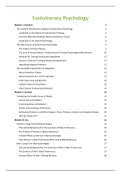Samenvatting
Evolutionary Psychology - Summary
- Vak
- Instelling
- Boek
This is a summary for the course Evolutionary Psychology (part of the Social psychology major/ minor) at Tilburg University. It is primarily based on the sixth edition of the book "Evolutionary Psychology: The New Science of the Mind" by Buss but also contains additional notes on knowledge clips th...
[Meer zien]





